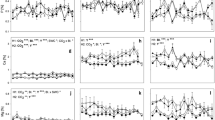Abstract
We grew a C4 grass from the Serengeti ecosystem under ambient (370 ppm) and elevated (700 ppm) CO2, and under clipped and unclipped conditions to test whether regrowth following grazing would be affected by elevated CO2. Above-ground productivity was slightly decreased under elevated CO2, and was similar between clipped and unclipped plants. Regrowth (clipping offtake) following clipping was similar in the two CO2 treatments, and there was no CO2 by clipping interaction on biomass, productivity, or leaf nutrient concentrations. Based on this evidence, we suggest that C4 grasses from the Serengeti will show little direct response to future increases in atmospheric CO2.
Similar content being viewed by others
References
Bazzaz FA (1990) The response of natural ecosystems to the rising global CO2 levels. Annu Rev Ecol Syst 21:167–196
Conway TJ, Tans P, Waterman LS, Thoning KW, Massarie KA, Gammon RM (1988) Atmospheric carbon dioxide measurements in the remote global troposphere, 1981–1984. Tellus 40B:82–115
McNaughton SJ (1985) Ecology of a grazing ecosystem: the Serenget. Ecol Monogr 55:259–294
McNaughton SJ (1988) Mineral nutrition and spatial concentrations of African ungulates. Nature 334:343–345
McNaughton SJ (1992) Laboratory-simulated grazing: interactive effects of defoliation and canopy closure on Serengeti grasses. Ecology 73:170–183
McNaughton SJ, Wallace LL, Coughenour MB (1983) Plant adaptation in an ecosystem context: effects of defoliation, nitrogen, and water on growth of an African C4 sedge. Ecology 64:307–318
Oesterheld M, McNaughton SJ (1988) Intraspecific variation in the response of Themeda triandra to defoliation: the effect of time of recovery and growth rates on compensatory growth. Oecologia 77:181–186
Oesterheld M, McNaughton SJ (1991) Effect of stress and time for recovery on the amount of compensatory growth after grazing. Oecologia 85:305–313
Poorter H (1993) Interspecific variation in the growth response of plants to an elevated ambient CO2 concentration. Vegetatio 104/105:77–97
Reekie EG, Bazzaz FA (1987) Reproductive effort in plants. 1. Carbon allocation to reproduction. Am Nat 129:876–896
Ruess RW (1988) The interaction of defoliation and nutrient uptake in Sporobolus kentrophyllus, a short-grass species from the Serengeti Plains. Oecologia 77:550–556
Shipley B, Peters RH (1990) A test of the Tilman model of plant strategies: relative growth rate and biomass partitioning. Am Nat 136:139–153
Wigley TML, Raper SCB (1992) Implications for climate and sealevel of revised IPCC emissions scenarios. Nature 357:293–300
Author information
Authors and Affiliations
Rights and permissions
About this article
Cite this article
Wilsey, B.J., McNaughton, S.J. & Coleman, J.S. Will increases in atmospheric CO2 affect regrowth following grazing in C4 grasses from tropical grasslands? A test with Sporobolus kentrophyllus . Oecologia 99, 141–144 (1994). https://doi.org/10.1007/BF00317094
Received:
Accepted:
Issue Date:
DOI: https://doi.org/10.1007/BF00317094




